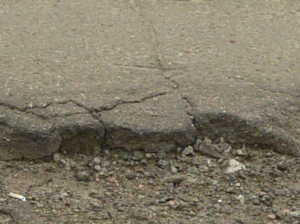
How to Get the Most Accurate Bid from an Asphalt Company
You aren’t a professional paver, and no one expects you to know everything about asphalt paving. However, you are in charge of sourcing a reliable asphalt contractor, so there are a few basics you should know about common pavement issues and how to make calculations so you know you are getting the most accurate bid from asphalt companies.
Be familiar with common pavement issues
In order to understand and be sure the contractor is bidding on what you really need, you should know common issues, what causes them and what the usual fix entails. Read through the chart below to get a basic understanding, so you will know whether the asphalt company is recommending a common fix.
Alligator Cracking
 What is it?
What is it?
A network of multi-sided cracks (blocks) that look like the skin of an alligator. The block size depends on how deep the structural failure goes.
What causes it?
It can be caused by weakness in the surface, base or sub grade of the pavement, or it may be because the surface or base is too thin. Poor drainage can also be the culprit. Without repair, water gets into cracks causing roughness and possibly deteriorates to a pothole.
What’s the fix?
Because there is a structural failure, the only possible solution to alligator cracking is to perform a full-depth patch.
Longitudinal Cracking
 What is it?
What is it?
Cracks that are parallel to the pavement’s traffic flow.
What causes it?
These can be a result of pavement fatigue, daily temperature cycles, base shrinkage, and/or poor joint construction. Allows moisture infiltration, roughness, and it may indicate the possible onset of alligator cracking and structural failure.
What’s the fix?
Cracks measuring 1/2 inch or less can be sealed. For more severe cracks, removing the cracked pavement layer and replacing it with an overlay is needed.
Transverse Cracks
 What is it?
What is it?
Single cracks that run perpendicular to the pavement’s traffic flow.
What causes it?
Similar to longitudinal cracks, transverse cracks can be caused by daily temperature cycles, base shrinkage, and/or poor joint construction. Untreated, these cracks allow moisture infiltration and cause roughness.
What’s the fix?
Cracks measuring 1/2 inch or less can be sealed to prevent moisture from entering into the sub grade. For more severe cracks, removing the cracked pavement layer and replacing it with an overlay is needed.
Slippage Cracks
 What is it?
What is it?
Crescent-shaped cracks or tears in the surface layers of newly laid asphalt.
What causes it?
If a tack coat was not used to bond the asphalt layers or if a prime coat was not used to bond the asphalt to the underlying stone base course, braking or turning wheels cause the pavement surface to slide and deform. Untreated, the cracks will allow moisture infiltration and cause roughness.
What’s the fix?
All of the areas exhibiting the “stretch marks” will need to be removed and will require a partial or full depth patch.
Raveling
 What is it?
What is it?
Very porous, eroding asphalt on the pavement surface.
What causes it?
One common cause for raveling is laying asphalt too late in the season. Untreated, loose debris on the pavement, and water collecting in the pock marks result in vehicle hydroplaning and loss of skid resistance.
What’s the fix?
Raveling should be repaired by applying a thin hot-mix overlay. Some applications may include sand, chip or slurry sealing, or micro-surfacing.
Potholes
 What is it?
What is it?
Depressions in the pavement surface that penetrate all the way through the hot mix asphalt layer down to the base course. They are usually roundish but may vary in shape and generally have sharp edges and vertical sides near the top of the hole.
What causes it?
Common causes for potholes are alligator cracking that has not been repaired, thin areas in the asphalt layer allowing water infiltration, and asphalt mix deficiencies. Untreated, potholes enlarge rather quickly and often cause vehicular damage.
What’s the fix?
Full-depth patches are necessary where the entire depth of pavement is distressed.
Edge Cracks
 What is it?
What is it?
Longitudinal cracks within one or two feet of the edge of the pavement.
What causes it?
The most common causes for edge crack include poor drainage conditions and lack of support at the pavement edge. As a result underlying base materials settle and become weakened.
What’s the fix?
Repairing requires removing any vegetation at the edge of the pavement and fixing any drainage problems. Less severe cracks can be sealed or filled to prevent further deterioration. More severe deterioration requires removing and reconstructing to full depth (and correcting any support issues).
Understand how asphalt needs are calculated
You probably want to go into any competitive bid with a general idea of what it goes into estimating, so let’s take a look at how to calculate your asphalt needs. Knowing that hot mix asphalt sells by the ton and coverage varies based on the mix of aggregate and binder, it is a good rule of thumb to figure that most asphalt mixes for parking lots will weigh 145 pounds per cubic feet of coverage.
- Determine the recommended thickness. Parking lots expecting light duty usage should be 4-5″ thick, while parking lots designed for heavy duty or truck use should be 7-8″ thick.
- Find the cubic footage needed. Multiply the length in feet by the width in feet by the depth in feet . For example, a 100-foot wide by 200-foot long lot with a depth of 5″ (.417 feet) would equal 8,340 cubic feet.
100 ft × 200 ft × .417 ft = 8,340 ft3
- Find the amount of asphalt needed. Multiply the cubic footage by 145 to find the total weight needed, then divide by 2,000 to convert it into tons.
8340 ft3 × 145 lb/ft3 = 1,209,300 lbs
1,209,300 lbs ÷ 2,000 = 604.65 tons
NOTE: Parking lots should also have an 8″ crushed gravel base.
By understanding a few of the basics of asphalt paving, you are a more informed buyer that can compare bids with ease. Knowing what to expect in terms of repairs will also allow you to better plan for and minimize disruptions. For reliable and trustworthy paving partners, contact DC Construction to bid on your next project.

 What is it?
What is it? What is it?
What is it? What is it?
What is it? What is it?
What is it? What is it?
What is it? What is it?
What is it? What is it?
What is it?